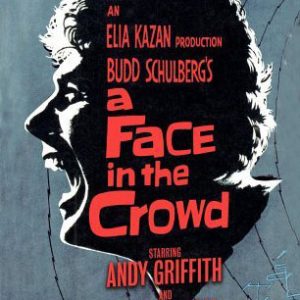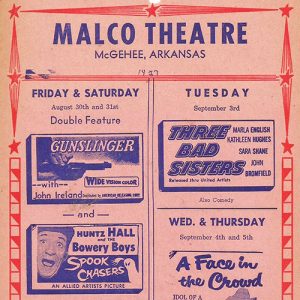calsfoundation@cals.org
A Face in the Crowd
A Face in the Crowd was a 1957 movie drama based on the short story, “Your Arkansas Traveler,” written by Budd Schulberg. It concerns a fictional Arkansas native, its opening scenes were set in northeastern Arkansas, and it was filmed on location in Piggott (Clay County) using local residents as extras. The film marked the screen debut of Andy Griffith and Lee Remick, along with being Walter Matthau and Tony Franciosa’s first major roles. It is significant for its prophetic theme of the cult of celebrity, the power of television, and the merging of entertainment and politics.
Writer Budd Wilson Schulberg (1914–) and director Elia Kazan (1909–2003) had previously worked together on the film, On the Waterfront (1954), based on Schulberg’s script. Both men had testified in the televised House Committee on Un-American Activities hearings in 1952, with controversial results. (Kazan admitted to being a former Communist Party member and named other members he knew.) They decided to make another movie together, based on Schulberg’s short story, “Your Arkansas Traveler,” showing the new medium of television’s power to make or break a performer or a politician.
“Your Arkansas Traveler” was the first story in Schulberg’s collection of short stories, Some Faces in the Crowd (1953). Schulberg reworked the story for the movie, to be called A Face in the Crowd, with a few changes: the heroine’s name, Marcia Coulihan in the story, was changed to Marcia Jeffries for the film; she meets Larry “Lonesome” Rhodes in the fictitious Pickett, Arkansas, in the movie (Fox, Wyoming, in the story), and while the short story ends with Lonesome’s death, the film ends on a more cautionary note, with Lonesome still alive and his resurgence predicted by a press agent.
The movie depicts Lonesome’s rise and fall as a media personality in 1950s America as television replaces radio as the most powerful form of mass communication. Marcia Jeffries (played by Patricia Neal) has a small-town radio show called “A Face in the Crowd” in the fictitious Pickett, on which she interviews ordinary people in northeastern Arkansas. At the fictional Tomahawk County jail, she meets the drunken vagrant Rhodes, played by a feral Andy Griffith. With animal magnetism, Rhodes plays guitar, sings, and tells stories of his “outrageous home town, Riddle, Arkansas.” Marcia arranges for Lonesome to have his own show on her uncle’s radio station in Pickett. He proves so popular that they move on to Memphis and then to New York, where he has a national television program, a precursor to modern talk shows called “Lonesome Rhodes’ Cracker Barrel.” Lonesome becomes a nationwide celebrity with great influence and tries to use his power to get a dubious politician elected president. Marcia is stunned at what he becomes and turns on a microphone so that his comments—calling his audience “suckers” and “stupid idiots”—can be heard on the air. His popularity declines overnight, but at the end, a press agent predicts that he will rise again in some form, citing the losing battle against demagogues.
Adding an early touch of “cinema verite” to the film was Kazan’s use of some of the popular television personalities of the day who themselves had influence on popular opinion. Playing themselves in uncredited roles to add to the realism of the film, they included Benett Cerf, Faye Emerson, Betty Furness, Virginia Graham, Burl Ives, Sam Levenson, John Cameron Swayze, Mike Wallace, Earl Wilson, and Walter Winchell. Actors who appeared uncredited in the movie also include Lois Nettleton, Rip Torn, and Charles Nelson Reilly. Music for the film was composed by folksinger Tom Glazer (“More,” “A Worried Man,” and the popular parody “On Top of Spaghetti”), whose song, “Mama Guitar,” was performed by Griffith/Rhodes throughout the movie.
There are many Arkansas references in the screenplay. Lonesome visits the Pickett High School field to judge “Miss Arkansas Drum Majorette of 1957.” His suite of offices in New York includes a wall with “an idealized diorama of Pickett. Everything is the last word in neo-Arkansas Madison Avenue plush-ultra.” He refers to himself as “yer old Arkansas traveler Lonesome Rhodes” and to his teenage, baton-twirling bride as “my little Arkansas sweet-pertater.”
Shooting for the movie began in August 1956, in Piggott and ended in November in New York. The use of Piggott for the location came about through Otto “Toby” Bruce of Piggott, a friend and assistant to author Ernest Hemingway, whom he met in 1928. Hemingway was a regular visitor to Piggott with his wife, Pauline Pfeiffer, whose family lived there. Toby Bruce accompanied the Hemingways to their home in Key West, Florida, where Bruce met Schulberg, who spent the winter there. After hearing of Schulberg’s project, Toby Bruce suggested Piggott for the upcoming film based on “Your Arkansas Traveler.” Kazan and Schulberg went to Piggott, deciding that was indeed the place to shoot.
In addition to the high school football field, other scenes shot in Piggott include the old jail and Clay County Courthouse, as well as the pool at the Pfeiffer home. Radio station KDRS in Paragould was sketched by set designers and re-created in New York as Marcia’s small-town station. Some scenes were shot on location with KDRS staff. Station owner-manager Ted Rand can be seen in the film as an audio engineer wearing headphones and talking into a microphone while seated at a console, doing a remote broadcast. KDRS ran announcements about the need for extras and where and when they should report. Members of the film production team, including Tom Glazer and Andy Griffith, were also interviewed on the air.
Kazan praised local residents in the published screenplay, saying, “I wish I could mention them all by name: the good people of Piggott, Arkansas, who opened their homes to us.” He used many locals as extras, including baton twirlers and marching bands from Piggott and Paragould (Greene County) in the drum majorette scene. Residents of the community had good relations with the movie company. In 2004, the Piggott Chamber of Commerce used “A Face in the Crowd” as the theme for their annual banquet.
When the film was released on May 28, 1957, it received a mixed reception from both critics and the public. Many found its message about television’s power to merge entertainment and politics to be outlandish as well as unpatriotic. However, when the video was released in 2000 in a series called “The Controversial Classics,” it received rave reviews; the DVD was released in 2005, also to glowing reviews. Many contemporary critics compare Andy Griffith’s powerful performance in A Face in the Crowd to James Dean and Marlon Brando. However, for the rest of his career, Griffith preferred to play a more affable character such as Sheriff Andy Taylor of Mayberry, rather than the dark, chilling Lonesome Rhodes.
A Face in the Crowd had its Piggott premiere at the Carolyn Theatre on May 31, 1957. It won the Berlin Festival Award for Best Screenplay that year, though no other major awards. Today, it is almost universally recognized as a classic—decades ahead of its time and an eerily accurate look at the future.
On September 15, 2007, a fiftieth anniversary celebration of the movie was held in Piggott, with Academy Award–winning actress Patricia Neal as guest of honor, plus a special presentation on the movie’s significance by noted film critic Dr. Foster Hirsch. The event included a showing of the film, commentary by Neal and Hirsch, and a banquet dinner attended by several hundred people, many of whom were in the movie. Some of the guests brought memorabilia from their participation in the film, and Neal toured the town to see locations where the movie was made and was reunited with her local stand-in.
Many commentators drew parallels between the figure of Lonesome Rhodes and Donald Trump, a real estate mogul and reality television star who was elected to the presidency of the United States in 2016 on the Republican Party ticket. Conservative columnist Cal Thomas called the movie as “the template” for Trump’s rise, while Marc Fisher of the Washington Post described the movie as “a revealing and cautionary portrait of what happens when a non-politician captures the American imagination, expresses the frustrations and aspirations of the people, wins hearts and trust, and litters the landscape with choice reminders that beneath his truth-telling lies a surly streak of contempt.” Perhaps not coincidentally, TCM (Turner Classic Movies) aired A Face in the Crowd on January 20, 2017, the day of Donald Trump’s inauguration.
For additional information:
A Face in the Crowd. DVD. Warner Home Video, 2005.
“A Face in the Crowd.” Internet Movie Database. http://www.imdb.com/title/tt0050371 (accessed August 2, 2023).
Heard, Kenneth. “Movie Makes Years Fall Away in Piggott.” Arkansas Democrat-Gazette. September 17, 2007, pp. 1B, 3B.
Kazan, Elia. A Life. New York: Alfred A. Knopf, 1988.
Laursen, Eric. “Grounded in Reality: How Piggott, Arkansas Helped Create A Face in the Crowd.” Arkansas Review: A Journal of Delta Studies 45 (August 2014): 124–130.
O’Neal, Sean. “Not Even a Movie as Cynical as A Face in the Crowd Could Predict Donald Trump.” AV Club, November 10, 2016. http://www.avclub.com/article/not-even-movie-cynical-face-crowd-could-predict-do-245666 (accessed August 2, 2023).
Schulberg, Budd. A Face in the Crowd: A Play for the Screen. New York: Random House, 1957.
———. Some Faces in the Crowd. New York: Random House, 1953.
Tapper, Jake. “Still Falling for It.” The Atlantic, November 2020, pp. 38–40. Online at https://www.theatlantic.com/magazine/archive/2020/11/jake-tapper-elia-kazan-trump/616471/ (accessed August 2, 2023).
Nancy Hendricks
Arkansas State University
 Arts, Culture, and Entertainment
Arts, Culture, and Entertainment Mass Media
Mass Media Movies
Movies A Face in the Crowd
A Face in the Crowd  A Face in the Crowd Ad
A Face in the Crowd Ad 



I believe that the band and some of the majorettes were from Poplar Bluff, Mo. (a little larger small town located about 25 miles from Clay County, Ark.).